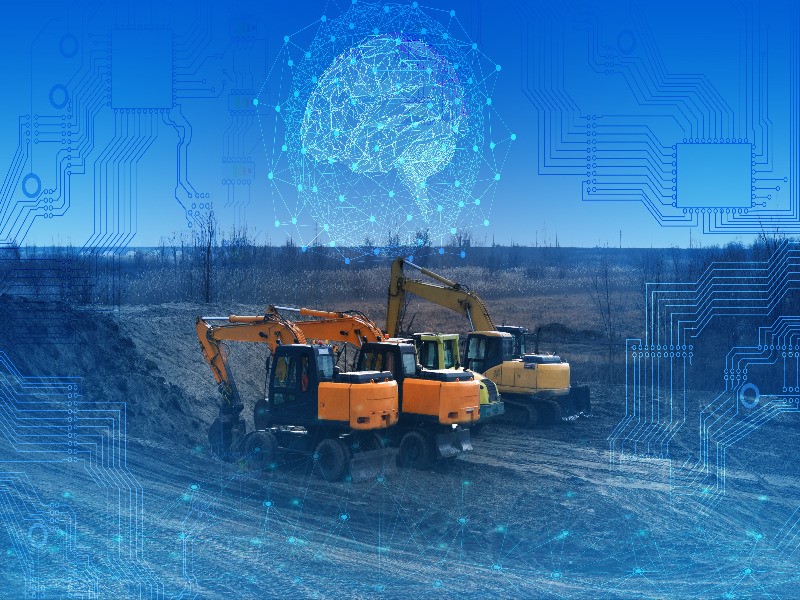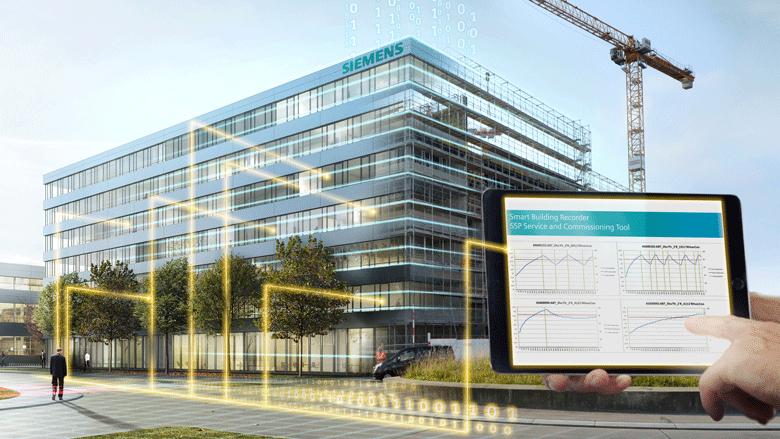Every industry needs technological innovation, including construction and the Construction Equipment (CE) sector. The application of artificial intelligence (AI), which has the potential to promote productivity, efficiency, and safety on the jobsite, has been gradually increasing in the CE industry over the past few years.
What can artificial intelligence do for the construction and equipment industry?
Construction has always been a risky business. This is because there is a potential for danger and accidents in the workplace due to the use of heavy machinery, uneven ground, frequent activity, and human mistakes. Despite the attention paid to health and safety and the employment of numerous technologies and approaches, danger still lurks over the job site. This highlights the significance of artificial intelligence-integrated tools and machine learning, which have the ability to boost construction sites’ efficiency and safety at the same time.
The demand for better results, the urgency with which projects must be completed, and the necessity to address the issue of skilled labor scarcity are a few of the drivers driving the expansion of artificial intelligence in the Construction Equipment industry. Additionally, the deployment of drones, robots, and autonomous vehicles in the construction business is unmistakably supporting the development of artificial intelligence in the Construction Equipment sector. Companies are implementing these technologies for mapping, aerial imaging, surveying construction sites, and automating construction activities. Numerous prospects are emerging as a result of the development of artificial intelligence technology in the Construction Equipment industry.
Benefits of artificial intelligence in Construction Equipment industry:
Companies are becoming more aware of the advantages that artificial intelligence-enabled equipment may provide for addressing not only health and safety issues but also enhancing productivity. Here are some advantages of artificial intelligence for the CE sector:
- AI – integrated equipment not only has the capacity to assure safety, but also offers many other advantages including the ability to automate all the tedious and repetitive operations that would otherwise take a lot of time on the jobsite.
- AI may also assist novice operators of complicated and heavy equipment, such as motor graders and backhoe loaders, in completing challenging jobs that would otherwise take a lot of time and produce subpar results.
- AI can also solve the main problem that the CE sector is now experiencing, which is a lack of qualified and experienced operators. Typically, qualified operators with experience operating the equipment safely are needed to operate heavy machinery like backhoe loaders or motor graders because it goes without saying that any mistake can result in serious harm to the operator, the machinery, and even other workers on the workplace. However, either it’s difficult to find skilled operators or hiring them is expensive. Therefore, given the lack of skilled workers, artificial intelligence can assist contractors and owners of construction companies to get by with less-skilled workers as the majority of the tasks are simple to complete by using advanced technologies.
- AI systems can also aid in preventative maintenance. Business owners can use artificial intelligence to identify patterns that result in failures and forecast outcomes, such as whether CE will fail if it is not serviced after a predetermined length of time. The EarthMaster Backhoe Loader from Mahindra Construction Equipment (MCE) merits special attention in this situation. The equipment includes REMOTECARE, an intelligent communication system that keeps the fleet manager or business owner continually updated about the unit.
- With the help of REMOTCARE, business owners can stay informed about the status of their equipment throughout the day and receive SMS notifications for essential business information such as daily work reports, maintenance reminders, fuel level information, low engine oil warnings, and other updates. By helping owners of businesses regain control over their machinery and manage it from the convenience of their office, automobile, or home, this advances the concept of operating independence.
The following are some of the most significant technological developments in construction machinery:
Three dimensional printing
One of the largest innovations in the construction sector is 3D printing, which is being widely used by businesses to produce tools, machinery parts, materials, and large pieces of heavy equipment. The method of creating three-dimensional items out of digital programme files is referred to as this type of printing. The use of 3D printing in the manufacturing of construction equipment helps manufacturers create replacement parts for damaged equipment quickly and easily.
Businesses can utilise 3D printing to construct a full piece of equipment in addition to producing high-quality replacement parts and components. The heat exchanger, stick, and cab are the three main 3D pieces of the excavator that the Oak Ridge National Laboratory printed. More businesses will probably print out building tools and parts as 3D printing technology develops, enabling quicker and more precise manufacture.
Robotic Equipment
The use of robotic technology in the construction sector is probably going to increase. One of the best instances of this is the use of drones, which can be remotely controlled and flown over project sites to collect data. They are frequently used by businesses to examine work sites in hazardous areas, approve development phases, and conduct aerial surveys. These drones give operators additional knowledge about a job site and assist businesses in determining where it is safe to utilise their heavy equipment.
More autonomous robotic machinery that doesn’t require an operator is also available. These self-contained pieces of heavy machinery are excellent at doing repetitive jobs and include cutting-edge technology that can adapt to varied situations. For instance, robotic excavators have remote monitoring systems, GPS navigation, and compactors that can automatically adapt to different site conditions. Teams can employ autonomous robotic equipment to delegate repetitive, time-consuming work to automated equipment, freeing up staff for more sophisticated duties.
Total computerization
The widespread use of computers in building projects is one of the largest developments in the rental equipment sector. Computers can be used by businesses to help with project planning, payroll management, and customer communication. However, computers also assist with construction machinery. Many manufacturers include microchips into their machinery to help with controls and monitoring systems. Because of the increased computerization, operators and businesses may access more data and have more control over their equipment.
Predictive Analysis through Internet of things (IOT)
Construction and equipment firms benefit greatly from the Internet of Things (IoT) since it provides a tonne of useful data for them to employ. IoT stands for the internet of things, which is a network of devices such as software and sensors that collect and share data with other systems and devices. Many businesses have added software and sensors that communicate across a network to their construction equipment.
Construction and equipment industries leverage the data collected by IoT to support operations, such as using the technology to collect consumption and GPS data. Additionally, they use it for predictive analysis to keep track of the upkeep of their equipment and forecast when repairs or inspections are necessary before malfunctions take place. Because it is less likely that a machine will break down in the field, predictive analysis saves owners of construction equipment money on expensive repairs and increases the usage rate of their equipment.
How Artificial Intelligence is changing the construction and Equipment Industry:
Construction and Equipment industries have benefited from the cloud, analytics, and more mobility as a result of technology’s advancements. The latest technology has also increased demand for affordable leasing choices, giving businesses the chance to adopt IoT and improve their operations.
Companies now have the chance to use technology to enhance their operations. Here are some ways that recent developments can help these businesses improve their operations:
Gain more information about assets: Companies now have access to an overview of all their assets thanks to modern technologies. A company’s fleet information can be delivered by cloud services and apps, allowing for improved long-term planning. For instance, a business can check how many pieces of rental equipment they have access to by using a cloud service. They can then rapidly advise prospective customers about the availability of their equipment.
Improve the inventory process of spare parts: The wealth of information provided by current technology to rental organizations enables them to optimize their inventory. Companies examine the findings to get useful knowledge about their most often required consumables and spare parts. A rental company will therefore be more inclined to discontinue maintaining an extra stock of parts that they rarely utilize. They can also be more ready by keeping a consistent supply of the most essential components on hand.
Being more proactive with maintenance: Rental firms can better monitor the state of their equipment with sensors on construction equipment and other monitoring technology. A team can instantly receive a warning and take action when a sensor detects a problem to prevent further damage. Apps and other software tools can help keep track of the equipment’s prescribed maintenance intervals and remind workers to do preventative maintenance when it is necessary.
Construction safety: Contrary to labourers in other industries, construction workers experience life-threatening accidents or severe injuries on the job very frequently. The level of safety can be raised at locations by implementing Machine Learning. It can be used to evaluate, pinpoint, and quickly report any alleged bug. When visual and acoustic data from a building site emerges, Machine Learning can be applied to identify safety dangers and transmit safety updates to reduce heightened hazards. The use of Machine Learning on construction sites has the potential to significantly increase safety. It can be used to find, evaluate, and report any irregularity right away.
Limit Cost Overruns: Without a question, construction projects are expensive and have large expenditures. Even when all possible costs are anticipated, such projects frequently exceed their budget. Artificial Neural Networks are used in these situations to estimate cost overruns on projects. The scale of the project, the type of contract, and the project managers’ qualifications are all taken into account. Artificial Intelligence allows remote access to practical training materials for the workforce, allowing for quick skill and knowledge advancement.
Better Designs: Machine learning can improve designs to make spaces better for the people who will eventually utilise them. Similarly, before beginning construction, employees might use machine learning to find flaws and mistakes in the design. In its place, machine learning can do that, ultimately saving teams valuable time that can be put to better use. You can even test different environmental circumstances and settings in the model using machine learning. The use of technology can assist in determining whether a specific design feature is optimal or can foresee whether it can cause problems in the future.
Increased productivity: When Machine Learning software is used to construction projects, productivity increases. Users of the software solutions may keep an eye on and manage routine tasks at sites where things like concrete pouring, bricklaying, electricity, flooring, plumbing work, and roofing are being done. Project managers can also monitor work being done on the job site in real-time. They make use of facial recognition, in-person cameras, and other comparable technologies to gauge employee productivity and compliance with policies.
Risk Mitigation: Risks in construction projects can take many different forms, including risks related to safety, time, quality, and cost. Since multiple subcontractors are working on various crafts simultaneously on larger projects, there is additional risk involved. In order to free up the project team’s time and resources to concentrate on other critical elements, contractors now use AI and machine learning solutions to manage risk on the construction site. Concerns can be consistently given a priority using AI. Subcontractors are given risk rankings so that construction managers can collaborate closely with high-risk teams to reduce risk.
Increased Lifecycle: In addition to architecture and design, facility management may also benefit from the application of machine learning to increase the entire lifecycle of an asset. Important information is typically lacking in facilities management. As a result, it is challenging to manage on-site repairs and upgrades effectively and affordably. Machine learning can help to streamline the procedure by gathering and using information and data. Work orders and other documents and data can be accurately categorised and the pertinent circumstances can be assessed in real-time. By doing this, the administrative weight is lifted off of individuals, allowing them to concentrate on the actual issue at hand.
AI and Big Data in Construction and post construction:
In a time when an infinite quantity of data is being created every day, AI systems now have access to an unending amount of data for learning from and improving on every day. Every employment site becomes a data source for AI. Images and videos taken with mobile devices, drones, security sensors, and building information modelling have yielded a large amount of data (BIM). Construction sector experts and customers have the opportunity to examine data and acquire insights from using the data thanks to artificial intelligence (AI) and machine learning. Advanced analytics and AI-powered algorithms can obtain useful insight by using sensors, drones, and other wireless technologies to gather data on buildings, bridges, roads, and anything else in the built environment. According to this reasoning, AI can keep track of emerging issues, decide when preventative maintenance is required, and even direct human behaviour to get the optimal security and safety outcomes.








